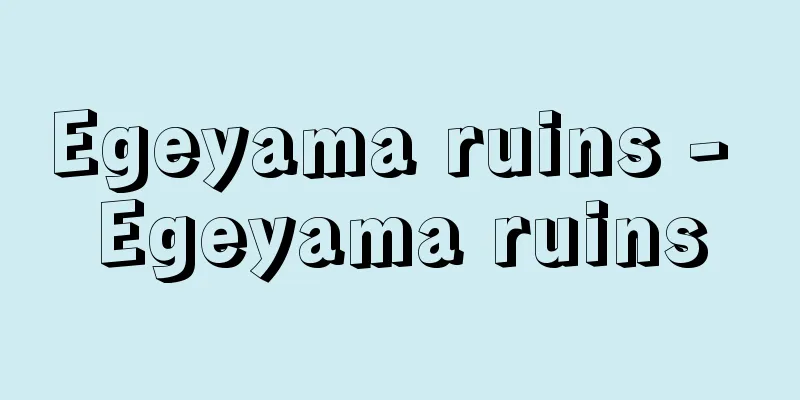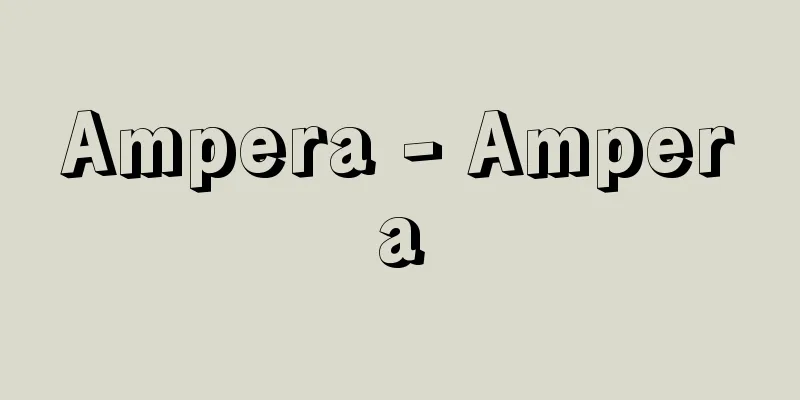Gidayu-bushi

|
A type of joruri. It is called "Gidayubushi" because it was started by Takemoto Gidayu (later known as Takemoto Chikugonojo), but in Osaka it is simply called "Joruri." It is music for puppet theater (now Bunraku), and the contents of the script (called Maruhon) are expressed using four different speaking styles: "Iro," "Kotoba," "Jiai," and "Fushi." However, these techniques have undergone various changes as puppets have developed, improvements have been made to their operation, and they have become intertwined with shamisen playing techniques, so we will look at the development of Gidayubushi with an emphasis on the progression of the tunes. [1] The Age of Color In 1684 (Jokyo 1), Takemoto Gidayu founded the Takemotoza Theatre in Dotonbori, Osaka. This marked the beginning of Gidayu-bushi. Gidayu admired the musical style of Inoue Harima-no-jo and was also influenced by Uji Kaga-no-jo, and brought together the so-called Ko-joruri. In other words, he established the use of basic melodies such as "mie" and "okuri" to create a structure for the music, and solidified the foundation of the musical form. However, because shamisen techniques were underdeveloped, the melody was not fixed and it had to be centered on color. Color is a way of speaking that is difficult to distinguish from lines and melody, and can be spoken in any way at the discretion of the performer. It was also an era when puppets were used by one person, such as "tsukkomi" and "sashikomi," and karakuri also appeared. Although the puppets were small, a variety of techniques were used in the performances of Chikamatsu Monzaemon's "Sonezaki Shinju" (1703) and "Meido no Hikyaku" (1711). Meanwhile, Toyotake Wakatayu, who left the school of Gidayu, founded the Toyotakeza Theatre. According to "Ima Mukashi Ayatsuri Nendaiiki" (published in 1727), his puppetry was "a musical piece with a strange and moral character" like Bun'yabushi or sekkyo, but his narrative style also became the mainstream of Gidayu, and was distinctive in the works of Ki Kaion and "Hojo Tokiyori-ki" (1726). It is assumed that Wakatayu, who was "beautiful sound", was good at more melodic tunes compared to Gidayu's "big sound". Takemoto Masatayu (later known as Takemoto Harima no Shojo), who succeeded Gidayu, recited "Kokusenya Kassen" (1715) by Chikamatsu and "Ashiyadoman Ouchi Kagami" (1734) by Takeda Izumo. However, in the case of "Hirakana Seisuiki" (1739), for example, one person was responsible for the opening, second, third and fourth parts of the five-part structure. With the modern melody, one person would not be able to recite it. This is proof that the style of storytelling at that time was very simple. In Harima Shōjō's later years, the shamisen had developed somewhat, and the number of key points on the sannosen string had increased to 12 (now 16). [2] The era of lyrics In the 1730s, when color was mainstream, assistants were added to the left hand and foot of the puppet during the performance of "Ashiyadoman Ouchi Kagami." This is said to be the beginning of "sannin gakari." Eventually, the eyes and mouths of the puppets were designed to move, and progress was made to the point that in "Genpei Nunobikinotaki" (1749), Saitou Betto Sanemori's puppet "looks like a human" (Jorurifu). Now puppets need the same expression techniques as humans, that is, the technique of dialogue. This is called "kotoba." The lyrics were not just conversations or monologues, but also included realistic techniques for crying, laughing, coughing, etc. The scripts gradually became more similar to modern plays, and the dialogue and narration (togaki) sections began to be clearly separated. Works such as "Sugawara Denju Tenarai Kagami" (1746), "Yoshitsune Senbonzakura" (1747), and "Kanadehon Chushingura" (1748), which were written in collaboration with Takeda Izumo and others, fulfill these demands. Moreover, unlike the previous generation of Chikamatsu and Kaion, Izumo and others foreshadowed the large-scale theme of a confrontation with national law. Gidayu-bushi, which places emphasis on the words, is easy to understand, and succeeded in attracting large audiences incomparable to those of the previous generation, and both the Takemoto Theater and the Toyotake Theater prospered greatly. This is what is told in "Taketoyo Koji". It goes without saying that the works mentioned here were also incorporated into kabuki and became representative Japanese theater. The courtiers who were active during this period included TAKEMOTO Yamatonojo, TAKEMOTO Masadayu (the second), TAKEMOTO Konotayu, TAKEMOTO Shimatayu, and TOYOTAKE Komatayu. [3] The era of Chiai While lyrics developed through the efforts of the tayu, the shamisen gradually developed its technique and began to turn the parts that corresponded to explanations and togyo into melodies. Such sections with inflected rhythms are called Chiai. Tsuruzawa Bunzo was the pioneer in composing, and the review "Yami no Tsubute" praises Bunzo as "the originator of modern times." Finally, the shamisen began to add beautiful inflected rhythms to the dialogue parts of the script. This was the birth of the so-called "Sawari." In addition, the shamisen alone began to connect the lines between lyrics, albeit briefly. This was the birth of "Aino-te." Such efforts inevitably increased the number of kansho, and the combinations became more complex. This is where musical scores come in. Tsuruzawa Seishichi's shamisen score "Shu" is said to have been invented in 1781 (Tenmei 1). Works that appeared during the period when the shamisen began to play an active role include Chikamatsu Hanji's "Honcho Nijūshikou (The Twenty-Four Filial Piety of Japan)" (1766), "Imoseyama Onna Teikin (The Teachings of the Lady of Imoseyama)" (1771), "Shinpan Utazaimon (New Edition of Poetry Festival Texts)" (1780), and "Igagoe Dochū Sugoroku (The Road to Iga-goe Sugoroku)" (1783). Hanji's works depict a conflict between the "beauty" of nature and the "ugliness" of human society, and "love" plays a major role in harmonizing and fusing the two. A work by Chikamatsu Monzaemon that had been left unused since its premiere has been revived after more than 50 years. "Meido no Hikyaku" was revised to "Keisei Koibikyaku" and "Shinju Ten no Amijima" was changed to "Shinju Kamiya Jihee", and the story began to show a form suited to the new technology of shamisen and puppets. Takemoto Masadayu (III) and Takemoto Nakatayu were able to meet the demands of the new era. Others who gained fame were Takemoto Sometayu, who showed strength in lyrics, Takemoto Harutayu, who was skilled in the geomancy, and Toyotake Komadayu (II and III), who had a beautiful voice. [4] The Age of Fushi In 1791 (Kansei 3), the famous artist Michosai wrote "Hanakenuki" in which he wrote that the shamisen was "pulled down as the hand moved" and that "the shamisen that was difficult to pull was refitted to the style of a puller." The technique of the shamisen continued to improve, and its shape became the thick neck we see today. Eventually, the shamisen discovered that it could produce beautiful melodies, and began to add the lines spoken by the tayu to the melody. This is called fushi. The tayu, who had previously focused solely on speaking, was now forced to sing. This trend became more noticeable after the 1780s, and works featuring michiyuki began to be revived. One such example is the michiyuki in "Yoshitsune Senbonzakura," which was performed again in 1805 (Bunka 2), 58 years after its premiere. Scenes such as "Tamamo-no-Mae" and "Shikino Kotobuki" were also performed with great enthusiasm. As the shamisen became more popular, a succession of musically rich works were produced, including the huge hit "Akoya no Kotozeme" in 1798 (Kansei 10), "Muken no Kane," "Horikawa no Sarumawashi," and "Sanjusangendo no Kiyari Ondo." The wisdom of the three arts, Toyotake Fumotodayu, Takemoto Takumidayu, Toyotake Tomoedayu, the shamisen players Nozawa Kichibei (first and third generation), Tsuruzawa Kanji, and the puppeteers Yoshida Shingo and Yoshida Tatsugoro, came together to transform Gidayu-bushi into music suitable for three puppeteers. Puppet theater had been abandoned for a time as entertainment for the masses, but in 1805 (Bunka 2), a new theater (later the Bunrakuza) opened at Uemura Bunrakuken. Puppet theater once again became a dream-filled entertainment industry. It spread throughout Japan. [5] After the Meiji Period Gidayu-bushi, which reached perfection in the late Edo period, was called the "master of music." This means the king of shamisen music. However, even in the Meiji period after 1868, shamisen players such as Toyosawa Danpei (II) and Toyosawa Hirosuke (V), as well as Takemoto Koshijidayu (later Settsu Daijo) and Takemoto Osumidayu, continued to work on modifying the melody. This was partly to compete with puppeteers led by Yoshida Tamazo, but the progress of the technique stagnated after the Russo-Japanese War. Instead, a trend emerged that respected the "style" of the predecessors. In particular, there was an active movement to explore the artistic style of the premiere tayu and to master the spirit of Joruri. Then, Toyotake Kotsubodayu (later known as Yamashiro Shojo) and Takemoto Tsunadayu (8th) dug deeper into the inner workings of Joruri, and finally reached the level of artistic perfection. The present day is an extension of that trend. Furthermore, Gidayu-bushi has been designated as an Important Intangible Cultural Property as a whole since 1955 (Showa 30) as Bunraku puppet theater (the chanter, shamisen and puppet). Among the individuals, Toyotake Yamashiro Shojo, the 6th Takemoto Sumitayū, and the 8th Takemoto Tsunadayū, as well as the 4th Takemoto Seiroku in shamisen, were the first to be recognized as holders of Important Intangible Cultural Properties in the same year. Others who were recognized include the 10th Toyotake Wakatayu, the 4th Takemoto Koshijitayu, the 4th Takemoto Tsunadayū, the 7th Takemoto Sumitayū, and the 9th Takemoto Tsunadayū, as well as the 6th Tsurusawa Kanji, Nozawa Matsunosuke, the 2nd Nozawa Kizaemon, the 10th Takezawa Yasichi, the 5th Tsurusawa Enza, the 4th Nozawa Kinshi, the 8th Takezawa Danroku (later the 7th Tsurusawa Kanji), and Tsurusawa Seiji. Furthermore, in 1980, Gidayubushi, performed by members of the Gidayubushi Preservation Society, was designated as a whole Important Intangible Cultural Property, and from within this, Takemoto Tosahiro's Joruri was individually designated as such in 1982, Tsurusawa Tomoji's Shamisen in 1998, and Takemoto Komanosuke's Joruri in 1999. (In 1953, the Bunraku Theatre changed the spelling of "Tayu" to "Dayu". This article followed that lead.) [Yoshihiro Kurata] "Reprint of 'Joruri Amateur Lectures' by Sugiyama Soni'an (1975, Otori Publishing)" ▽ "'Gidayu Chronology Early Modern Edition', 6 volumes compiled by the Gidayu Chronology Early Modern Edition Publishing Committee (1979, Yagi Shoten)" ▽ "'Gidayu Chronology Early Modern Edition Supplementary Volume', 2 volumes compiled by the Gidayu Chronology Early Modern Edition Publishing Committee (1990, Yagi Shoten)" [References] | [Supplementary material] |Source: Shogakukan Encyclopedia Nipponica About Encyclopedia Nipponica Information | Legend |
|
浄瑠璃(じょうるり)の一種目。竹本義太夫(後の竹本筑後掾(ちくごのじょう))が始めたので「義太夫節」というが、大阪では単に「浄瑠璃」とよぶ。人形芝居(いまの文楽(ぶんらく))の音楽で、「色(いろ)」「詞(ことば)」「地合(じあい)」「フシ」という4種類の語り方を用いて台本(丸本(まるほん)という)の内容を表現していく。しかしこれらの技法は、人形の発達や操作技術の改良、あるいは三味線の演奏技術と絡み合って多様な変化をしたので、曲節の推移に重点を置いて義太夫節の展開を眺めてみる。 〔1〕色の時代 1684年(貞享1)竹本義太夫は大坂道頓堀(どうとんぼり)に竹本座を創立した。このときをもって、義太夫節の成立とする。義太夫は井上播磨掾(いのうえはりまのじょう)の曲風を慕い、また宇治加賀掾(うじかがのじょう)の影響も受け、いわゆる古浄瑠璃を集大成した。すなわち、「三重」「オクリ」など基本的旋律の使用法を規定して楽曲の体裁を整え、音楽形式の基礎を固めた。しかし、三味線の技術は未発達なために曲節は固定せず、色中心にならざるをえなかった。色というのは、台詞(せりふ)とも旋律とも区別しかねる語り方で、演者の裁量によりどのように語ってもよいのである。また人形は、「突っ込み」とか「差し込み」といった一人遣いの時代で、からくりも登場する。小さい人形とはいえ、多彩な技術が駆使されて、近松門左衛門作『曽根崎(そねざき)心中』(1703)や『冥途の飛脚(めいどのひきゃく)』(1711)が上演された。一方、義太夫の門から脱した豊竹若太夫(とよたけわかたゆう)は、豊竹座を創立した。『今昔操年代記(いまむかしあやつりねんだいき)』(1727刊)によると、文弥節(ぶんやぶし)か説経のように「風義かはりたる音曲」であったが、その語り口も義太夫節の一大主流となり、紀海音(きのかいおん)の作品や『北条時頼記(ほうじょうじらいき)』(1726)に特色を発揮した。「大音」の義太夫に対して「美音」の若太夫は、より旋律的な曲節が得意であったと推測される。義太夫の後継者となった竹本政太夫(まさたゆう)(後の竹本播磨少掾(はりまのしょうじょう))は、近松作『国性爺合戦(こくせんやかっせん)』(1715)や竹田出雲(いずも)作『芦屋道満大内鑑(あしやどうまんおおうちかがみ)』(1734)を語った。しかし『ひらかな盛衰記』(1739)を例にすると、1人で五段構成のうちの大序(だいじょ)、二段目切(きり)、三段目切、四段目切を受け持っている。現代の曲節では、1人で語りこなせるものではない。とりもなおさず、当時はごく単純な語り方であった証拠となろう。 播磨少掾の晩年には、三味線もいくらか発達し、三の絃(いと)の勘所(かんどころ)は12か所(現在は16)に増えていた。 〔2〕詞の時代 色が主流をなしていた1730年代、『芦屋道満大内鑑』の上演時に人形の左手と足に介添(かいぞ)えがついた。「三人懸(がか)り」の始まりという。やがて人形の目や口も動くように考案され、『源平布引滝(げんぺいぬのびきのたき)』(1749)では、斎藤別当実盛(さねもり)の人形が「人の如(ごと)く見ゆる」(浄瑠璃譜)と評されるまでに進歩した。いまや人形には、人と同じ表現法、つまり台詞の技術が必要である。これを詞とよぶ。詞は単なる会話や独白ばかりでなく、泣き、笑い、咳(せき)などにも写実的な技巧が凝らされた。いきおい台本も現代の戯曲に近くなり、台詞と地(ト書)の部分が明瞭(めいりょう)に区分され始める。竹田出雲ら合作の『菅原伝授手習鑑(すがわらでんじゅてならいかがみ)』(1746)、『義経千本桜(よしつねせんぼんざくら)』(1747)、『仮名手本忠臣蔵(かなでほんちゅうしんぐら)』(1748)などは、そうした要求を満たす作品である。しかも出雲らは、前時代の近松や海音とは違って、国法との対決というスケールの大きなテーマを伏線とした。とにかく詞に重点を置く義太夫節は、理解しやすいという理由もあって、前時代とは比較にならぬ観客の大動員に成功し、竹本座も豊竹座も大いに繁盛した。『竹豊故事(ちくほうこじ)』の伝えるところである。ここに記した作品は歌舞伎(かぶき)にも取り入れられ、日本を代表する演劇となったのはいうまでもなかろう。なおこの時代に活躍した大夫は、竹本大和掾(やまとのじょう)、竹本政太夫(2世)、竹本此太夫(このたゆう)、竹本島太夫(しまたゆう)、豊竹駒太夫(こまたゆう)らである。 〔3〕地合の時代 大夫の努力によって詞が発達したのに対し、三味線は徐々に技術を開発し、説明やト書に相当する部分を旋律化し始めた。そうした曲節のついた箇所を地合とよぶ。先兵となって作曲に取り組んだのが鶴沢文蔵(つるざわぶんぞう)で、評判記『闇の礫(やみのつぶて)』は文蔵を「近代の元祖」と称賛している。ようやく三味線は、台本の台詞の部分にも美しい曲節をつけ始めた。いわゆる「サワリ」の誕生である。また歌詞と歌詞の間を、短いながらも三味線だけでつなげるようになった。「合の手(あいのて)」の成立である。このような努力は必然的に勘所を増加させ、その組合せは複雑になっていく。ここに楽譜が登場してくる。鶴沢清七(せいしち)がつくった三味線の楽譜「朱(しゅ)」は、1781年(天明1)の創案だといわれている。三味線が活躍し始めた時代に現れる作品は、近松半二(はんじ)の『本朝廿四孝(ほんちょうにじゅうしこう)』(1766)、『妹背山婦女庭訓(いもせやまおんなていきん)』(1771)、『新版歌祭文(しんぱんうたざいもん)』(1780)、『伊賀越道中双六(いがごえどうちゅうすごろく)』(1783)などである。半二の作品には、自然の「美」と人間社会の「醜」が対立しており、それを調和させ、また融合させる働きとして、「愛」が大きな比重を占めている。なお、初演のまま放置されていた近松門左衛門の作品が、50年以上の歳月を経て復活してきた。『冥途の飛脚』が『けいせい恋飛脚(こいびきゃく)』と改作されて、また『心中天網島(しんじゅうてんのあみじま)』が『心中紙屋治兵衛(しんじゅうかみやじへえ)』となって、三味線や人形の新技術にふさわしい姿をみせ始めた。新しい時代の要請にこたえたのが竹本政太夫(3世)や竹本中太夫(なかたゆう)である。詞に強味を発揮する竹本染太夫(そめたゆう)や、地合に巧みな竹本春太夫(はるたゆう)、あるいは美声の豊竹駒太夫(2世、3世)らも名声をはせた。 〔4〕フシの時代 1791年(寛政3)画工として名高い耳鳥斎(にちょうさい)は『はなけぬき』を著し、三味線は「手の回るに任せ引倒」し、「引(ひき)にくひことは引能様(ひきよきやう)に拵(こしら)へ直し」ていると書き留めた。三味線の技術はますます進歩し、形状もいまのような太棹(ふとざお)になる。やがて、美しい旋律ができることを知った三味線は、大夫の語る文句をもそのメロディに乗せ始める。これをフシという。かつては語ることを専一にしてきた大夫は、この段階で歌う必要に迫られたのである。こうした傾向は1780年代以降に顕著となり、道行に特色のある作品が復活し始めた。『義経千本桜』の道行もそうで、初演から58年目の1805年(文化2)に再演される。『玉藻前(たまものまえ)』『四季寿(しきのことぶき)』などの景事(けいじ)も盛んに上演された。三味線の活躍に伴って、1798年(寛政10)『阿古屋の琴責(あこやのことぜめ)』の大ヒットをはじめ、『無間(むけん)の鐘』『堀川の猿廻(まわ)し』『三十三間堂の木遣音頭(きやりおんど)』など、音楽性の豊かな作品が続出してくる。豊竹麓太夫(ふもとだゆう)、竹本内匠太夫(たくみだゆう)、豊竹巴太夫(ともえだゆう)らの大夫陣と、野沢吉兵衛(初世、3世)、鶴沢寛治(つるざわかんじ)らの三味線、それに人形の吉田新吾(しんご)や吉田辰五郎(たつごろう)ら、いわゆる三業の英知が一体となって、三人遣いにふさわしい音楽へと義太夫節は脱皮した。民衆娯楽として一時期は見離されていた人形芝居に、1805年(文化2)新しく植村文楽軒(うえむらぶんらくけん)の芝居(後の文楽座)も開場した。改めて人形芝居は、夢多き娯楽産業となった。そして日本全国へと広がっていく。 〔5〕明治以降 江戸末期に完成の域に達した義太夫節は、「音曲の司(つかさ)」といわれた。三味線音楽の王者という意味である。しかし、1868年以降の明治時代になっても、豊沢団平(とよざわだんぺい)(2世)、豊沢広助(ひろすけ)(5世)を初めとする三味線陣、あるいは竹本越路太夫(こしじだゆう)(後の摂津大掾(せっつのだいじょう))、竹本大隅太夫(おおすみだゆう)らは、曲節の改変に取り組んでいく。吉田玉造(たまぞう)を中心とする人形と張り合うためでもあったが、日露戦争を境に技術の進展は停滞した。かわって台頭するのが、先人の「風(ふう)」を尊重する風潮である。とくに初演の大夫の芸風を探り、浄瑠璃の精神を究めようとする動きが活発になった。そして豊竹古靭太夫(こうつぼだゆう)(後の山城少掾(やましろのしょうじょう))と竹本綱大夫(つなたゆう)(8世)によって、浄瑠璃の内面が深く掘り下げられ、芸術性がようやく完成の域に達するのである。現代はそうした思潮の延長線上に位している。 なお義太夫節は、人形浄瑠璃文楽(ぶんらく)(大夫・三味線・人形)として1955年(昭和30)以来、重要無形文化財の総合指定を受けている。また個人としては、大夫では豊竹山城少掾、6世竹本住大夫(すみたゆう)、8世竹本綱大夫が、三味線では4世鶴沢清六(せいろく)が、同年重要無形文化財保持者に認定されたのを第1回に、以下、大夫では10世豊竹若大夫(わかたゆう)、4世竹本越路大夫、4世竹本津大夫、7世竹本住大夫、9世竹本綱大夫が、三味線では6世鶴沢寛治(かんじ)、野沢松之輔(まつのすけ)、2世野沢喜左衛門(きざえもん)、10世竹沢弥七(やしち)、5世鶴沢燕三(えんざ)、4世野沢錦糸(きんし)、8世竹沢団六(だんろく)(のち7世鶴沢寛治)、鶴沢清治が認定された。また1980年には、義太夫節保存会会員による義太夫節が重要無形文化財の総合指定を受け、そのなかから竹本土佐広(とさひろ)の浄瑠璃が1982年に、鶴沢友路(ともじ)の三味線が98年(平成10)に、竹本駒之助(こまのすけ)の浄瑠璃が99年に同各個指定を受けた(1953年に文楽座は「太夫」を「大夫」の表記に改めた。本項目もそれに従った)。 [倉田喜弘] 『杉山其日庵著『浄瑠璃素人講釈』復刻版(1975・鳳出版)』▽『義太夫年表近世篇刊行会編『義太夫年表 近世篇』全6冊(1979・八木書店)』▽『義太夫年表近世篇刊行会編『義太夫年表 近世篇 別巻』全2冊(1990・八木書店)』 [参照項目] | [補完資料] |出典 小学館 日本大百科全書(ニッポニカ)日本大百科全書(ニッポニカ)について 情報 | 凡例 |
<<: Northern worm - Northern worm
>>: Gidayu Chronology - Gidayu Chronology
Recommend
Danelaw
…Alfred united the English army and fought, and a...
Separate payment - Bechinou
〘Noun〙 ("Bechi" is the Go-on pronunciati...
Equal, E. - Equal
…Even in recent times, due to political upheaval ...
Shiragegaya (white hair grass) - Shiragegaya (English spelling) velvet grass
A naturalized plant of the grass family native to ...
khshathrapavan (English spelling)
…the title of a governor of a province in the Per...
Gastrocamera (English spelling)
Gastroscopy. Source: About Shogakukan Digital Daij...
Ascottie
… The following types of neckties are currently i...
Mikulicz-Radecki, J. von
…German physician. Born in Barmen (now Wuppertal)...
Saturn Nebula
A planetary nebula in the constellation Aquarius, ...
Endscraper
…It can be translated as a scraper or a sharpener...
Freed, A.
...Listening to the music of Haley and Presley, i...
Farmer soldier - Nouhei
They were established by the shogunate and variou...
Local Education Administration Law - Chihokyoikugyoseiho
(Abbreviation for "Law Concerning the Organiz...
Professional occupation - senmonshoku
Generally speaking, professionals are professiona...
Oligodynamics
…A small amount of metal dissolves in water, ioni...









